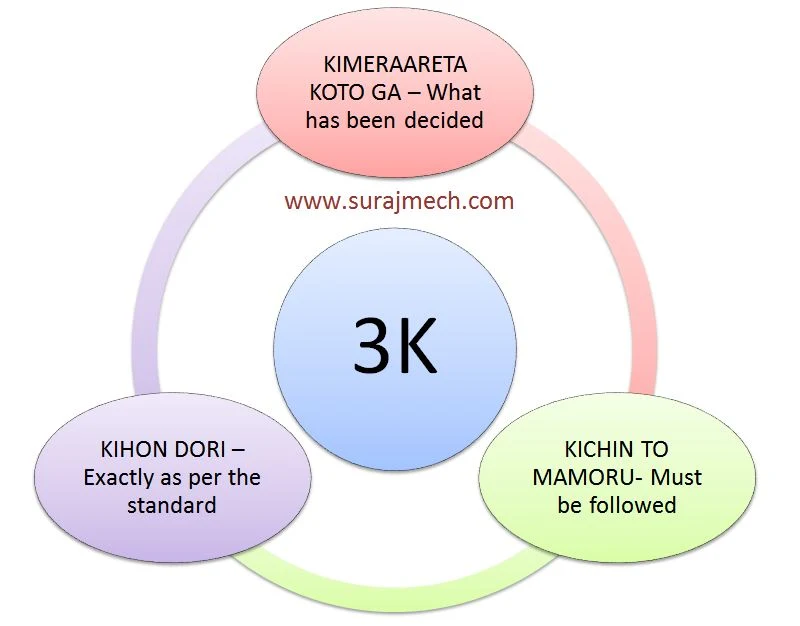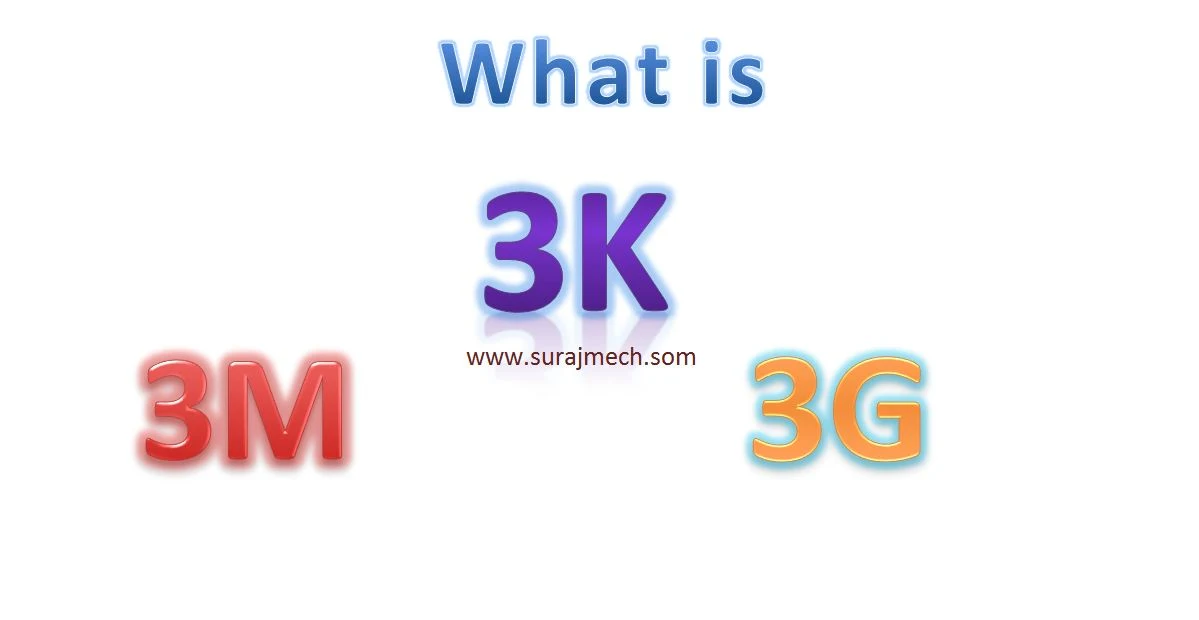What is 3M, 3K, 3G
- These words are widely used in Japanese industries. Whenever you visit in any Japanese company you will definitely listen these words.
- Basically these are “Best in-house practices followed on shop floor while working in industries. By adopting these Japanese techniques we can sustain best manufacturing quality.
3M
- One of the most important goals of Lean manufacturing is the elimination of waste.
- Taiichi Ohno, father of the Toyota Production System (TPS), defined three categories of waste: Mura, Muri, and Muda. While Muda is the most widely known, Muri and Mura are equally important to understand.
1. Muda
- Muda refers to processes / activities that don’t add value. These type of wastes do not help your business or workers in any way.
- They increase the costs and make tasks take much longer than they should. Wastes are defined in TPS as follows:
- Overproduction occurs when items are manufactured before they are required.
- Over processing occurs when extra work is put into a product or service than is actually required.
- Finding and eliminating Muda is necessary if you want to reduce costs, improve efficiency, and increase profits. However, if you don’t also address Mura and Muri, these benefits will be inconsistent or may even fade over time.
2. Mura
- Mura is a type of waste caused by unevenness in production and services. It is also caused when standards are non-exist or are not followed.
- One common example is when companies ramp up production to meet targets, even when there is no customer demand. This forces the sales department to rush to try to fill orders and creates a burden as the shipping department rushes to ship products before the end of the month.
- The result? Defects are manufactured into components. Customers receive inconsistent products or services. The production floor struggles to complete the large orders and becomes idle as orders slow. Even more concerning is that Mura creates muri (overburden), which in turn undermines efforts to eliminate the seven wastes of Muda.
3. Muri
- The third category of waste is the result of tasks or processes that are overly difficult, or ones that overburden workers. For the most part, this is caused when workers:
- Lack proper training
- Have no standards to follow
- Are given the wrong tools for the job
- When workers lack the right tools for the job, for example, tasks become much more difficult, taking more time and potentially damaging the product. For instance, working sheet metal with the wrong hammer tripling the time it takes to complete the task and requiring products to be reworked.
3K
KIMERAARETA KOTO GA – What has been decided
KIHON DORI – Exactly as per the standardKICHIN TO MAMORU- Must be followed
- See Example of traffic rules, what if one person does not stop at the red light. There could be an accident involving 1 to 2 people. But what if no one stops at the red light, lot of people will meet with accidents throughout the day.
- Similarly if standards are not followed in a factory, There will be lot of defects. The product quality will be very poor. There will be accidents and lot of wastage due to rejections. However, the most important requirement is the system / standard.
A standard should be:
- Correct
- Clear & precise
- Easily understandable for instance, if the worker does not understand English, a standard written in it of no use.
3G
- 3G (Gemba, Gembutsu & Gengitsu) is method used to gather fact about problems of gap. Whenever a problem occurs there are facts related with it, these facts are product on which problem occurs, place where problem is reported and when problem is reported.
- 3G (Gemba, Gembutsu & Gengitsu) is systematic way to gather fact about problem.
Gemba – Go to the spot
Gembutsu – Examine the object
Gengitsu – Check fact and figure
Gemba (Go to the spot)
- Gemba is Japanese term meaning “the actual place”, it is more often used to customer centric approach and one must visit customer’s Gemba to understand problem and opportunity, to gather and process data.- In real sense, if one needs to understand the fact/information related to problem then visit problem location. i.e. Assembly station, Machine, Inspection location, customer location.
Gembutsu – Examine the object
- We have seen that visit Gemba would facilitate you, collection of facts about problem. Gembutsu means examine object, objects are product, part, process and system on which problem is reported.
- Fact about object would be actual size, material, Hardness, form, geometry these are physical attribute of objects. Object is also going to provide facts about failure mode, failure pattern.
- Various inspection methods (Dimensional, Metallurgical, etc.) can be utilized to examine object as against specification.
Gengitsu – Check fact and figure
- Gengitsu is Japanese term used for checking fact and figure about the problem. Facts about problem and be best collected when you personally witness failure on Gemba. Witnessing problem is not really easy to manage considering fact that many times location may not be close to you.
- However, if in case you are not able to visit Gemba at least try to get failure photos, failure video.
- Facts about problems can be listed as below.
- When problem occurs?
- Who was Operator?
- Whether component meets Dimensional specification?
- How it is leaking?
- What type of noise?
- What is nature of occurrence, periodic, non-regular, interval, etc.?
Conclusion
3G (Gemba, Gembutsu & Gengitsu) would support is understanding facts about problem, which in turn facilitate correct and concise problem definition.




Post a Comment
Post a Comment
Please do not enter any spam link in the comment box.